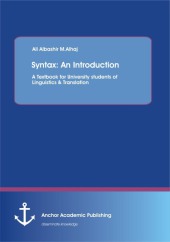 Neuerscheinungen 2015Stand: 2020-02-01 |
Schnellsuche
ISBN/Stichwort/Autor
|
Herderstraße 10
10625 Berlin
Tel.: 030 315 714 16
Fax 030 315 714 14
info@buchspektrum.de |

Ali Alhaj
Syntax: An Introduction: A Textbook for University students of Linguistics & Translation
Erstauflage. 2015. 72 S. 220 mm
Verlag/Jahr: ANCHOR ACADEMIC PUBLISHING 2015
ISBN: 3-9548988-9-6 (3954898896)
Neue ISBN: 978-3-9548988-9-3 (9783954898893)
Preis und Lieferzeit: Bitte klicken
Translation is as old as the art of writing or as old as history of education in general. It is occasioned by the social needs of people. Whenever, for instance, two linguistic groups interact as neighbors to each other, translation from and to each other´s languages becomes inevitable if they must meaningfully communicate with each other in matters of commerce, intermarriage, education, legal issues, etc. Religious books like those that the Holy Qur´an and the Bible have been facilitating essentially translated to numerous languages in different parts of the world.
Translation is also regarded a
s a significant key that connects the literary works of authors from diverse culture. It also plays a pivotal role in minimizing the cultural divergences. Translation has been widely practiced over the centuries in the world in general and in Arab world in particular. The founding mythology and the sacred texts of the dominant religions are all based on translations. In short, translation has been essential for development and change in literature, commerce, technology, politics, so on and so forth.
Translation mediates between languages, societies, and literatures, and it is through translation that linguistic and cultural barriers may be overcome. Traditionally, translation is considered a change of form, which is a change of surface structures from a source language into a target language. A rather simple definition of translation as "the replacement of textual material (SL) by equivalent textual material in another (TL)" is suggested by Catford (1990, p.20). In this respect, Catford is more concerned with formal language rules and grammar, rather than the context or the pragmatics of the text to be translated. Nonetheless, he stressed that:"Since every language is formally sui-generis, and formal correspondence is, at best, a rough approximate on it is clear that the formal meaning of SL items can rarely be the same"(Catford, 1990, p.36).Indeed, form is a vehicle of meaning, and translation consists mainly of transferring the meaning of the SL text into the TL. Hence, translation, according to Nida(2001,p.12),"consists of reproducing in the receptor language the closest natural equivalent of the source language message first in terms of meaning and secondly in terms of style". This definition reveals a notion of equivalence in translation at the semantic and stylistic levels. It views translation as a reproduction of a similar response of the TL reader by reproducing equivalent meaning and style. In other words, it favors a maximum equivalence of meaning and effect as suggested by F.E Tylor (2002, p.37)


